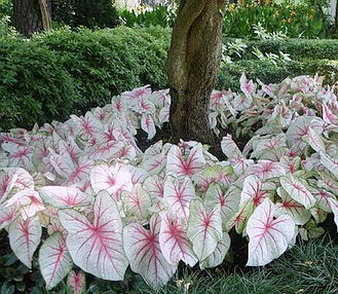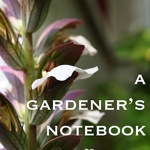Caladium bicolor ‘White Queen’
Wow! This nearly whit caladium just knocks you back when you see it. I can easily imagine this as a focal point among a shady, green garden. It would attract everyone’s eye, I am sure.
Discovered via Tumblr User, Rita Thomas
A tuberous-rooted perennial most often grown as an annual or a houseplant, ‘White Queen’ has large frosted-looking white leaves that have green margins and bright red veins that “bleed”. A great plant for full shade, it can also be grown in sun if provided with consistently moist soil. Greenish-white flower spathes appear in spring and are followed by white berries, but the foliage is the main show. Its arrow-shaped leaves light up a dark spot and work well as bedding or in containers. It can also be grown as a houseplant and tubers can be overwintered indoors.
Noteworthy Characteristics: Large white leaves with green margins and prominent red veining. Contact with the plant may cause skin irritation and stomach upset if ingested.
Care: In the garden, grow in moist but well-drained soil that is rich in humus and slightly acidic, in partial to full shade. If soil hasn’t warmed up yet, start tubers indoors. Lift for winter. As a houseplant, grow in a soilless mix in bright filtered light and high humidity.
Propagation: Divide in spring and dust cut tubers with fungicide.
Problems: Tuber rot, Southern blight, leaf spot, root-knot nematodes. Aphids and spider mites can bother plants indoors. — Fine Gardening
- Caladium bicolor ‘White Queen’ at Fine Gardening
- Caladium bicolor ‘White Queen’ at Brent and Becky’s Bulbs
- Caladium bicolor ‘White Queen’ at SF Gate
Previously in the Interesting Plant series:
- Fuchsia
- Palo Verde Tree (Parkinsonia florida)
- Espalier Fruit Trees
- California Poppy (Eschscholzia californica)
- Hydrangea ‘Zorro’
- Harlequin flower (Sparaxis tricolor)
- Erythronium
- Sempervivum
- Primula auricula
- Feathery Cassia (Senna auricula)
- Red Stick Dogwood (Cornus alba ‘Sibirica’)
- Japanese Maple (Acer palmatum)
- Kousa Dogwood (Cornus kousa)
- Giant Chalk Dudleya (Dudleya brittonii)
- Sunrose (Helianthemum nummularium)
- Australian/New Zealand Tea Tree (Leptospermum scoparium)
- Brugmansia Sanguinea
- Calico Monkeyflower (Mimulus pictus)
- Colocasia Esculenta
- Acer palmatum ‘Sango-kaku’ (Coral Bark Japanese Maple)
- Linderniaceae (formerly Torenia) Kuaui Deep Blue
- Passiflora (Passion flower)
- Firewheel Tree (Stenocarpus sinuatus)
- Anemone
- Allium Cowanii
- Symphyotrichum oblongifolius (Purple Aster)
- Hemerocallis ‘Derrick Cane’ (Daylily)
- Agastache ‘Aztec Rose’
- Rudbeckia hirta Moreno
- Kalanchoe Tomentosa
- Albuca namaquensis
- Hosta ‘Remember Me’
- Dahlia ‘Clair de Lune’
- Lovely silver-tinged fern on campus of Oberlin College, Ohio
- Tricolor Beech (Fagus sylvatica Purpurea Tricolor)
- Climbing Hydrangea (Hydrangea anomala petiolaris)
- Eremurus ‘Lemon Meringue’
- Lupine “Sunrise” (Lupinus hartwegii)
- Chinese Fringe Flower (Loropetalum chinense)
- Streptocarpus ‘Harlequin Blue’
- Nigella damascena (love-in-a-mist, ragged lady)
- Epiphyllum (Orchid Cactus)
- Sempervivum ‘Westerlin’
- Gladiolus ‘Kings Lynn’
- Hosta sieboldiana ‘Dorothy Benedict’
- Begonia “Escargot”
- Asparagus Pea (Psophocarpus tetragonolobus)
- Rosa banksiae (Lady Banks’ Rose)
- Primula ‘Victoriana Silver Laced Black’
- Oxalis versicolor
- Poached Egg Plant (Limnanthes douglasii)
- Parisian Carrots
- Fritillaria imperialis Rubra Maxima
- Clematis “Fascination”
- Swiss Chard “Bright Lights”
- Georgia Rattlesnake Melon
- Dianthus Barbathus “Green Ball” or “Green Trick”
- Coleus “Religious Radish”
- Black Forest Calla Lily
- Black Bamboo
Interesting Plant is a series from A Gardener’s Notebook blog and podcast that highlights the most interesting plants I find in my Internet and real-world travels — Douglas





